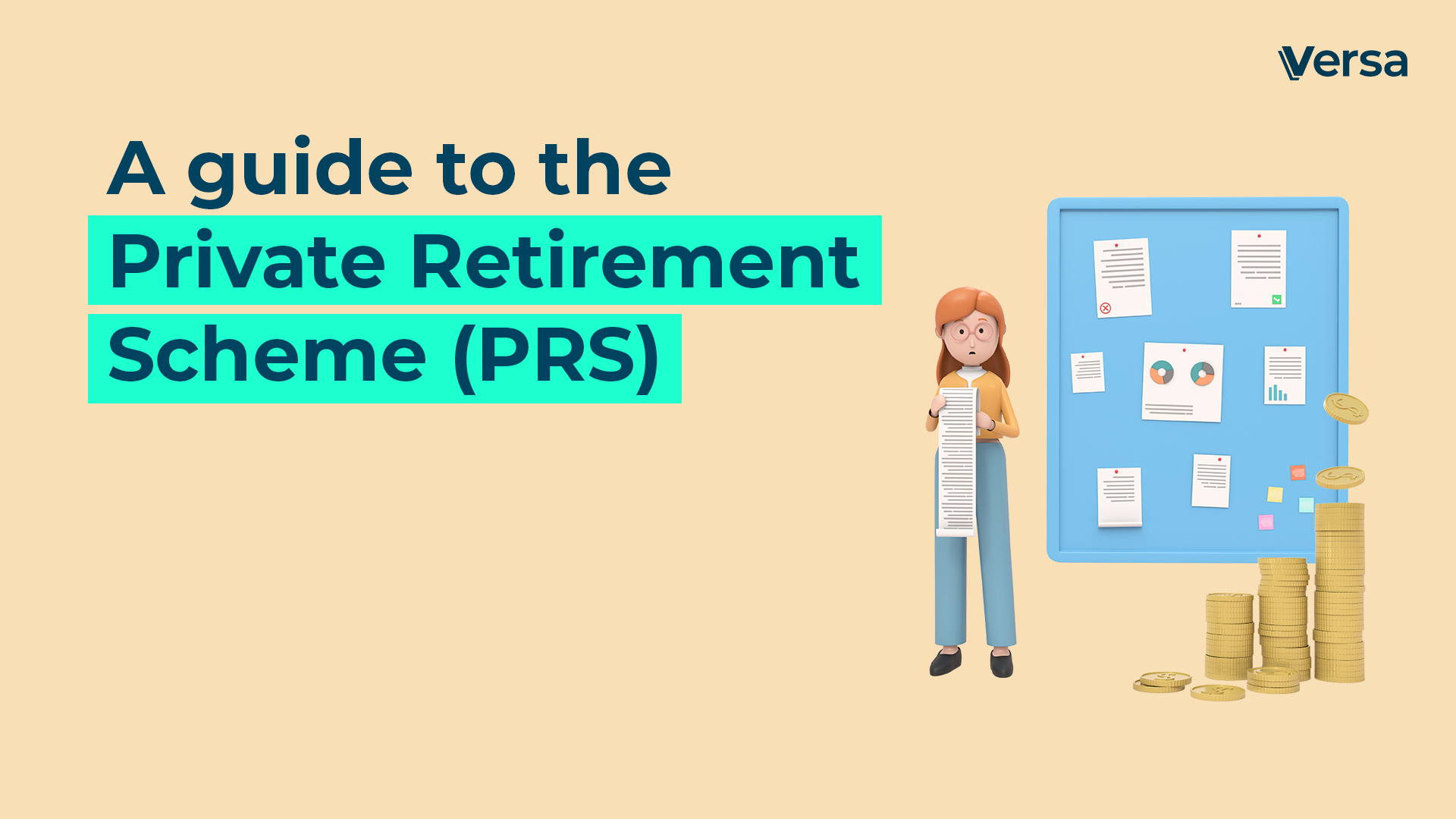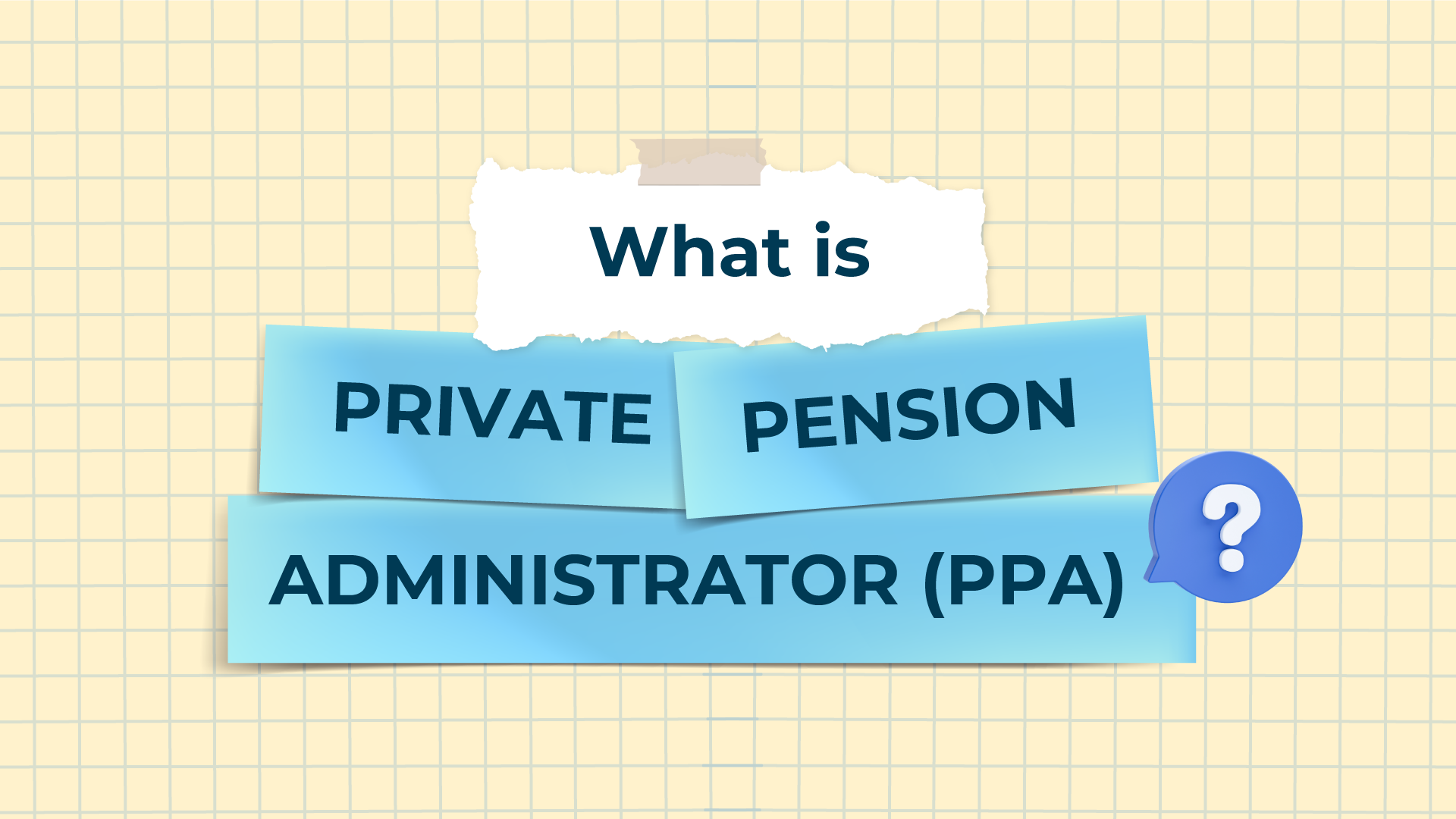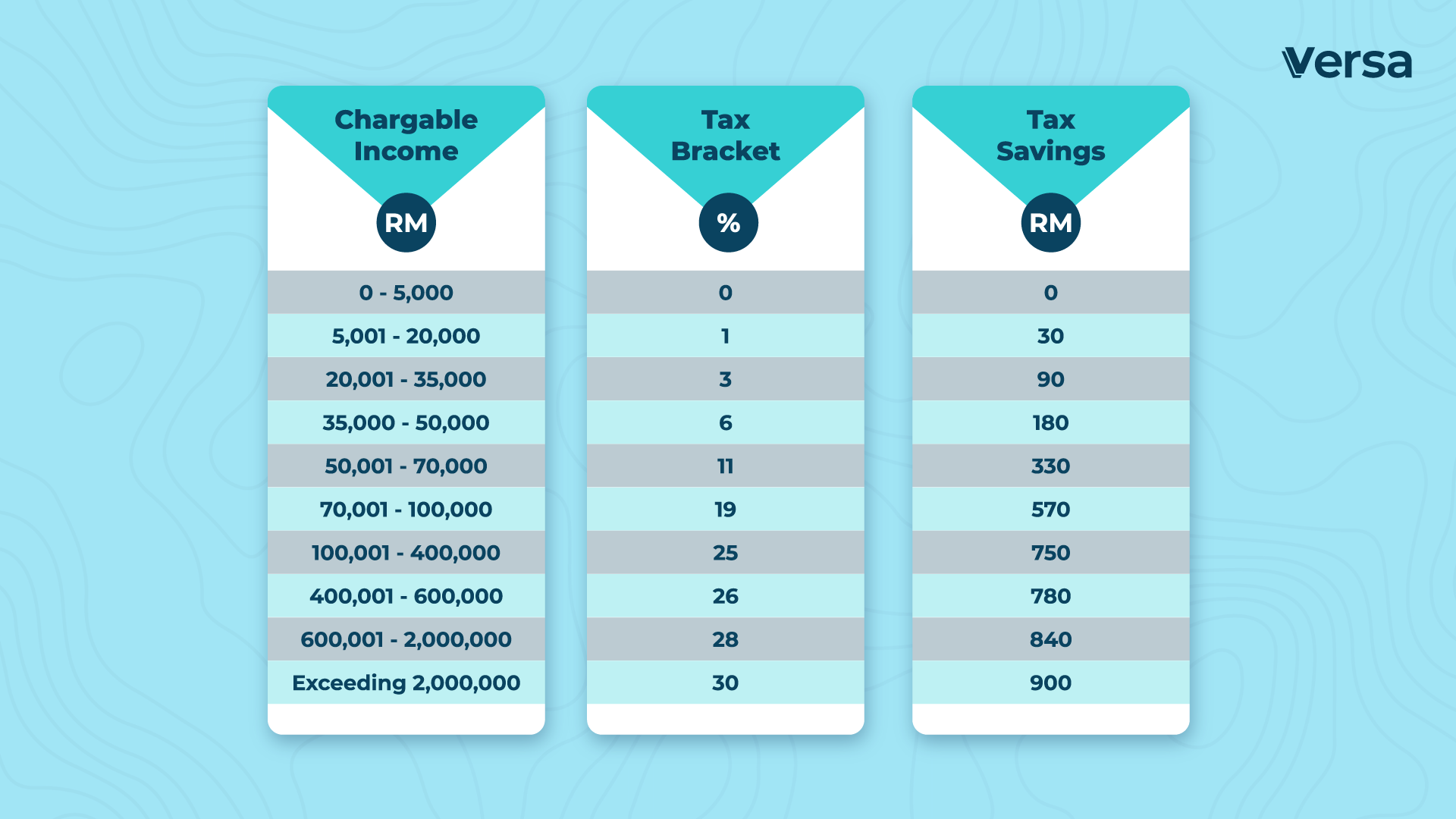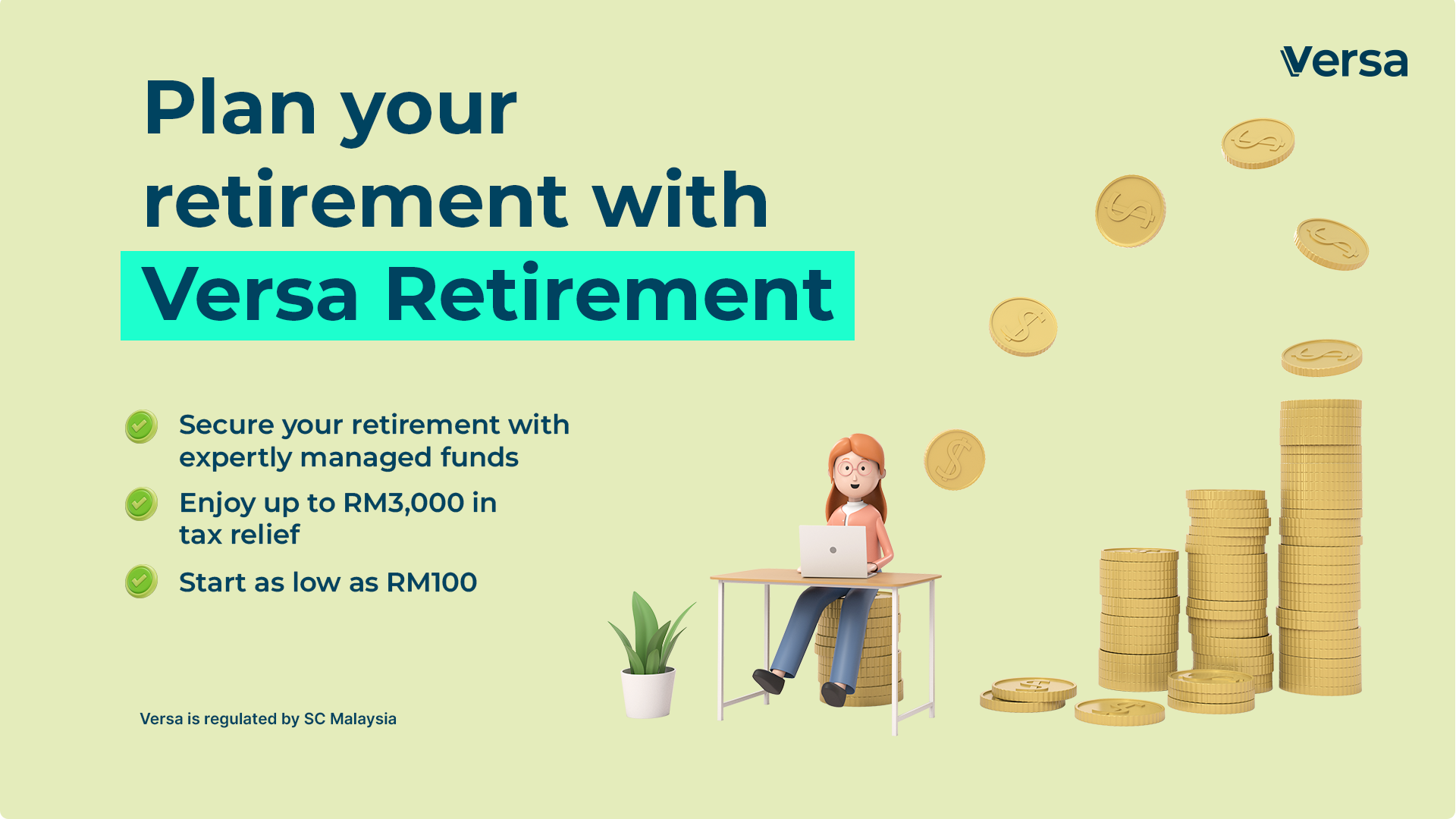
Everything You Need to Know About Private Retirement Scheme (PRS):
- Everything You Need to Know About Private Retirement Scheme (PRS):
- What is Private Retirement Scheme (PRS)?
- How Does PRS Work?
- Private Retirement Scheme (PRS) vs Employee Provident Fund (EPF)
- What is Private Pension Administrator (PPA) and its functions?
- Tips for Maximising Your PRS Return
- Investment Risks in PRS
- What are the Benefits of PRS?
- How to Choose the Right PRS for You?
- Types of PRS Funds
- How to Open a PRS Account?
- PRS Providers 2024
- Versa teams up with the experts at AHAM Asset Management Berhad to offer you six exciting PRS funds, catering to your preferences and risk appetite:
- How Much Can You Contribute to PRS and Benefit from Private Retirement Scheme Tax Relief?
- What are the Withdrawal Rules for PRS?
- What Happens to Your PRS Funds Upon Retirement?
Retirement planning is crucial for ensuring financial security in your golden years, and Private Retirement Schemes (PRS) in Malaysia, also known as PRS Malaysia, offer a compelling option for enhancing savings.
What is Private Retirement Scheme (PRS)?
A Private Retirement Scheme (PRS) is a voluntary long-term savings and investment scheme in Malaysia designed to help you accumulate funds for your retirement. Unlike mandatory programs, the PRS scheme allows you to choose your contributions and investment strategies, ultimately fostering financial independence in retirement. As a part of Malaysia’s financial landscape, PRS encourages better savings habits and offers various investment options to cater to different risk appetites. Therefore, understanding the features of PRS and selecting the best PRS fund 2024 is crucial for a secure retirement.

How Does PRS Work?
The PRS scheme operates by allowing you to contribute to a PRS fund, which is then invested in various financial instruments aimed at generating returns for your retirement savings. This clever structure not only promotes disciplined savings habits among investors but also offers you a diverse array of options tailored to your risk tolerance and financial goals.
You can choose between different types of funds, each featuring unique investment strategies, making it easier to align with your personal preferences regarding risk and return. Additionally, the PRS scheme encourages higher long-term savings rates through government incentives and tax relief, thereby growing a strong retirement landscape.
Contributions to the private retirement scheme fund can be made via regular monthly payments or lump-sum investments, allowing for flexibility based on your financial situations. The management of these funds is crucial as fund managers make strategic decisions to optimise returns, including maximising the PRS dividend history, and ensuring that each investment aligns with the growth objectives of the portfolio.
- You can review your performance regularly, thanks to accessible online platforms.
- Many utilise PRS calculators, also known as private retirement scheme calculators, which provide estimates on potential returns based on various contribution scenarios and investment periods.
In Malaysia, understanding the influence of the PRS return rate is essential, as it directly correlates with overall savings and future financial security. By leveraging these tools, you can make informed decisions, thereby maximising your retirement fund’s potential, ultimately leading to a more secure financial future.

Private Retirement Scheme (PRS) vs Employee Provident Fund (EPF)
When comparing the Private Retirement Scheme (PRS) with the Employee Provident Fund (EPF), it’s essential to understand their distinct objectives, structures, and benefits in managing retirement savings in Malaysia.
Both schemes serve crucial roles in ensuring financial stability during retirement, yet they operate under different frameworks. Unlike EPF, which is mandatory for employees in the formal sector, PRS is a voluntary scheme designed to enhance an individual’s retirement savings.
- PRS allows for more personalised investment choices, enabling individuals to select funds aligning with their risk tolerance.
- In contrast, EPF contributions are automatically deducted from salaries, ensuring consistent savings.
- Accessibility also varies; PRS offers greater flexibility in terms of withdrawals, typically allowing access under specific conditions like early retirement or financial hardship.
The return rates of PRS funds can often outperform the EPF’s fixed interest rates, providing an opportunity for higher growth potential over time.
What is Private Pension Administrator (PPA) and its functions?

The Private Pension Administrator (PPA) plays a crucial role in the management and regulation of the Private Retirement Scheme (PRS) in Malaysia, ensuring that the system operates efficiently and transparently, while also fostering a sense of security among participants for their financial future.
With its various regulatory responsibilities, the PPA oversees the integrity of the private retirement funds and ensures that all activities within the PRS scheme adhere to established guidelines. This governance encompasses several essential functions:
| ● Fund Management: The PPA actively manages the assets within the PRS, ensuring they are invested wisely, thus maximising returns for you. |
| ● Regulatory Oversight: It monitors compliance with laws and regulations, therefore safeguarding both the assets and interests of beneficiaries. |
| ● Participant Support: The PPA is dedicated to enhancing your understanding of your retirement savings options through educational resources and customer service. |
Ultimately, the PPA’s efforts not only secure the funds but also inspire confidence among people like you planning for your future!
Tips for Maximising Your PRS Return
To maximise your PRS return in Malaysia, several strategies can be employed, considering the dynamic nature of PRS funds and the importance of well-considered choices.
Investment Risks in PRS
Investing in a Private Retirement Scheme (PRS) involves certain risks that you must consider, particularly in relation to market volatility and the specific PRS fund chosen, as these factors can substantially impact long-term returns and overall financial stability.
Many participants may not fully understand how external market fluctuations can lead to variations in fund performance, affecting their retirement savings. In addition, sector-specific risks such as regulatory changes or economic downturns related to specific asset classes can also play a significant role in investment outcomes.
To illustrate further, consider the following risks associated with PRS investments, which can influence the private retirement scheme interest rate:
| 📉 Market Fluctuations: Rapid changes in the economy can cause sudden shifts in asset values. |
| 🔴 Sector-Specific Risks: Certain sectors may experience downturns that impact the funds heavily invested in them. |
These risks are often reflected in the interest rates of private retirement schemes, where higher risk typically correlates with the potential for greater returns. To mitigate these risks, participants can diversify their investments across different funds, consult financial advisors regularly, and remain informed about market trends.
What are the Benefits of PRS?
The benefits of enrolling in a Private Retirement Scheme (PRS) are multifaceted, providing participants with various advantages that contribute to a financially secure retirement, especially in the context of the PRS scheme in Malaysia.
1. Tax Relief
One of the most significant advantages of participating in a Private Retirement Scheme (PRS) is the tax relief offered to contributors, which can greatly enhance overall savings, allowing you to not only secure your financial future but also reduce your taxable income substantially during the years you contribute.
This tax relief works effectively by allowing you to claim deductions on your annual taxable income based on the amount invested in the scheme.
- The maximum allowable deduction can significantly vary, and understanding these limits is crucial for optimising benefits.
- By strategically planning contributions within these thresholds, you can effectively reduce your tax liabilities while simultaneously increasing your retirement savings.
- It becomes essential for you to keep track of your contributions to maximise the tax relief, ensuring they do not exceed the set limits.
Leveraging tax relief becomes a fundamental component of any long-term financial strategy for retirement.
This table provides an illustration of the tax savings amount you could enjoy from your annual RM3,000 PRS contributions.
For example, if your tax bracket is 19%, your RM3,000 PRS contributions will give you tax savings of RM570.

2. Investment Diversification
Investment diversification is another critical benefit of the PRS scheme, allowing you to spread risk across various asset classes within your chosen PRS funds.
This strategic approach not only enhances potential returns but also creates a safety net against market volatility. By incorporating different types of funds, such as equity, bond, and balanced funds, you can tailor your portfolios to align with your risk tolerance and financial goals.
- Equity funds expose you to stock market performance, while also opening opportunities for substantial growth.
- Bond funds typically provide more stability and income, appealing to those seeking lower risk.
- Balanced funds combine both equities and bonds, striking a middle ground for those who want exposure to both worlds.
By diversifying within your PRS investments, you not only improve your overall portfolio resilience but also navigate potential downturns more effectively, ensuring a more robust financial future through PRS Malaysia.
3. Professional Management of PRS Malaysia
The PRS scheme provides access to professional management of private retirement scheme funds, ensuring that investment decisions are made by seasoned experts in the financial field, emphasizing the Private Retirement Scheme benefits.
These fund managers play a pivotal role in navigating the complexities of investing, leveraging their extensive knowledge of market trends, asset allocation, and economic indicators. By implementing well-researched strategies, they aim to maximise returns while minimising risks.
You can greatly benefit from their expertise, particularly if you may lack the time or understanding necessary to effectively manage your retirement savings.
Here are a few key strategies these fund managers employ:
- Diversification:
Spreading investments across various asset classes to reduce risk. - Active Management:
Dynamically adjusting portfolios based on market conditions. - Research-Driven Decisions:
Making informed choices based on thorough analysis.
Ultimately, the guidance provided by fund managers in the PRS fund gives the power to everyday investors to secure their financial future with confidence, potentially exploring the best PRS fund 2024 options.
How to Choose the Right PRS for You?
Choosing the right Private Retirement Scheme (PRS) is a crucial decision that can significantly impact your retirement savings, making it essential to assess various factors before committing to a PRS fund.
1. Consider Your Risk Tolerance
Understanding your risk tolerance is vital when selecting a suitable PRS scheme, as it will influence your investment strategy and influence the type of PRS fund you should choose.
Determining personal risk tolerance involves evaluating various factors that impact individual comfort levels regarding investment risks. These factors include:
- Financial Goals 🥅
Your short-term and long-term aspirations can significantly shape your risk appetite. - Time Horizon ⌛
The duration you plan to stay invested affects how much risk you can handle; longer horizons often allow for greater risk-taking. - Market Knowledge 📚
Familiarity with market dynamics can bolster confidence in navigating potential losses.
By carefully considering these elements, you can gain a clearer understanding of your preferences. This knowledge is crucial as it translates into selecting a compatible PRS fund, ensuring that the chosen investment aligns with your comfort level and financial objectives.
2. Look at the Fund Performance
Evaluating the historical fund performance of potential PRS funds is crucial, as it provides insights into the PRS return rate in Malaysia and helps predict future performance.
Understanding this aspect involves looking at several key elements. You should consider the time frame of the historical returns, as different periods might yield varying results based on market conditions. The impact of economic factors, such as inflation rates and interest trends, can significantly influence fund performance.
When comparing different funds, it is essential to examine various performance metrics, including:
- Annualised returns
- Volatility measures
- Sharpe and alpha ratios
- Management expense ratios (MER)
By assessing these factors, you can make informed decisions about which funds align best with your investment goals. Ultimately, a comprehensive analysis can lead to more enlightened choices, encouraging long-term growth and financial security.
3. Check the Fees and Charges
Before committing to a PRS fund, it is essential to check all fees and charges associated with the PRS scheme, as they can significantly affect overall returns.
Understanding the different types of fees involved is crucial for any investor.
- Management fees are charged by the fund manager for overseeing the investments, which can vary greatly from one fund to another.
- Entry and exit fees may apply when you buy or sell units in the fund, potentially eroding your profits.
By being aware of these costs, you can make informed decisions that align with your financial goals. Transparency in the fund’s fee structure enables better comparisons, ensuring you know how your returns are impacted by these charges. Ultimately, a thorough understanding of these fees will help in maximising net gains.

Types of PRS Funds
The types of PRS funds available within the PRS scheme cater to various investment strategies and risk profiles, providing you with options that align with your financial goals.
Growth funds within the PRS scheme are designed for aggressive investors looking for higher returns through capital appreciation over the long term.
These funds primarily focus on investing in companies that exhibit significant potential for growth, often favouring sectors like technology or healthcare. You should anticipate volatility; while this can lead to substantial gains, it also comes with increased risks.
In pursuit of maximising returns, growth fund managers typically adopt strategies such as investing in emerging markets or small-cap stocks, which may provide considerable upward price momentum.
Investment strategies include:
- Technology sector focus
- Emerging market exposure
- Long-term capital appreciation
For individuals willing to embrace higher risk in exchange for the possibility of greater financial rewards, these funds present a compelling option, especially for those who are not averse to market fluctuations.
Moderate funds represent a balanced approach within the PRS scheme, appealing to investors seeking a mix of growth and stability.
The investment strategy typically involves a diversified portfolio, combining equities and fixed-income securities to mitigate risks while providing potential returns.
This dual approach caters to both conservative investors who prioritise capital preservation and those willing to embrace some level of risk for enhanced growth.
By focusing on medium-term goals, moderate funds offer liquidity and moderate volatility, making them suitable for you if you prefer a careful balance between risk and return.
- Typically hold 40-60% in equities
- 30-50% in bonds
- Maintains a diversified asset allocation
The blending of asset classes not only cushions against market fluctuations but also allows for growth opportunities through select equity investments.
Conservative funds in the PRS scheme cater to risk-averse investors who prioritise capital preservation and stable returns over aggressive growth.
These funds are designed with a focus on lower volatility, making them an attractive option for those who prefer to avoid the unpredictability often associated with the stock market. Investors in such funds can expect a portfolio that primarily includes bonds, cash equivalents, and other fixed-income securities, which generally offer more stability than equities.
- Low-risk nature ensures that investments are less susceptible to market fluctuations.
- A well-considered investment strategy focuses on generating consistent income while preserving the initial capital.
- Ideal for individuals nearing retirement or possessing a lower risk tolerance, as they help safeguard assets for future needs.
By choosing conservative funds, you can enjoy peace of mind knowing that your financial future is underpinned by a stable and predictable investment approach.

How to Open a PRS Account?
Opening a Private Retirement Scheme (PRS) account is a straightforward process that enables you to start saving for your retirement through the PRS scheme, allowing you to build a secure financial future tailored to your personal needs and goals.
To get started, prospective account holders need to gather some essential documentation. Here’s what is typically required:
- A valid identification card or passport
- Proof of income, such as recent pay slips or tax returns
- Bank account details for fund transfers
Once you have your documents ready, follow these simple steps:
- Visit an authorised PRS provider, either online or at their physical branches.
- Complete the application form, providing your personal details and selected PRS fund preferences.
- Submit your documentation, ensuring all information is accurate to avoid any delays.
For selecting appropriate funds, evaluate factors such as risk appetite, desired returns, and fund performance over time. It’s advisable to consult financial advisors for personalised insights, ensuring your retirement savings align with your long-term objectives.
PRS Providers 2024
The PRS providers approved by the Securities Commission 2024 are:
| COMPANY | TEL | HOTLINE | FAX | WEBSITE | |
|---|---|---|---|---|---|
| AHAM Asset Management Berhad | 603-2116 6000 | 1800-88-7080 | 603-2116 6100 | [email protected] | www.aham.com.my |
| AIA Pension and Asset Management Sdn. Bhd. | – | 1300-22-7771 | 603-2056 1091 | [email protected] | www.aia-prs.com.my |
| AmFunds Management Berhad | 603-2032 2888 | – | 603-2031 5210 | [email protected] | www.aminvest.com |
| Hong Leong Asset Management Bhd | 603-2081 8600 | 603-2081 8500 | [email protected] | www.hlam.com.my | |
| Kenanga Investors Berhad | – | 1300-88-3737 | 603-2172 3133 | [email protected] | www.kenangainvestors.com.my |
| Manulife Investment Management (M) Berhad | 603-2719 9271 | 1300-13-2323 | 603-2093 7377 | [email protected] | www.manulifeinvestment.com.my |
| Principal Asset Management Berhad | – | 603-7723 7260 | – | [email protected] | www.principal.com.my/prs |
| Public Mutual Berhad | 603-2022 6800 | 603-2022 5000 | 603-2022 6900 | [email protected] | www.publicmutual.com.my |
| RHB Asset Management Sdn. Bhd. | 603-9205 8000 | 1800-88-3175 | 603-9205 8100 | [email protected] | www.rhbassetmanagement.rhbgroup.com |
PRS (Private Retirement Scheme) fund managers are entities responsible for managing the funds within a PRS, which is a voluntary retirement savings program often seen in Malaysia. These fund managers are usually licensed and regulated financial institutions, such as banks, asset management companies, or insurance companies. Their main role is to manage investments in a way that aims to provide returns suitable for retirement savings.
PRS fund managers need to be verified and approved by regulatory framework to ensure they meet certain standards for financial safety and reliability. In Malaysia, for example, PRS fund managers are regulated by the Securities Commission Malaysia (SC). They must comply with strict guidelines, including those related to transparency, investment practices, and financial stability, to be licensed to manage PRS funds. This regulation is essential to protect investors and ensure the proper management of retirement funds.
Versa teams up with the experts at AHAM Asset Management Berhad to offer you six exciting PRS funds, catering to your preferences and risk appetite:
| 🟢 AHAM PRS Conservative Fund (PRS Conservative) |
| 🟢 AHAM PRS Moderate Fund (PRS Moderate) |
| 🟢 AHAM PRS Growth Fund (PRS Growth) |
| 🟢 AHAM Aiiman PRS Shariah Conservative Fund (PRS Conservative-i) |
| 🟢 AHAM Aiiman PRS Shariah Moderate Fund (PRS Moderate-i) |
| 🟢 AHAM Aiiman PRS Shariah Growth Fund (PRS Growth-i) |
You can choose to invest in one or more of these funds! Find out more about Versa Retirement here.
Every contribution you make will be divided into two accounts:
- 70% goes into Sub-Account A, which you can withdraw when you hit retirement age or if you leave Malaysia.
- 30% goes into Sub-Account B, available for withdrawal once per calendar year, subject to an 8% tax penalty on the pre-retirement withdrawal sum.

How Much Can You Contribute to PRS and Benefit from Private Retirement Scheme Tax Relief?
Understanding the contribution limits of the Private Retirement Scheme (PRS) is essential for effective retirement planning and maximising tax benefits, as these limits play a crucial role in determining how much one can invest each year without incurring penalties or losing potential tax relief opportunities. Furthermore, being aware of the private retirement scheme interest rate can help in forecasting potential returns.
For instance, you can contribute up to a certain percentage of your annual income to the PRS scheme Malaysia, which is capped at a predefined amount determined by regulations. This cap is generally reviewed periodically and may vary based on age or other factors.
- Annual Allowance: Each individual is allowed a tax-relief-capped contribution amount that can provide substantial tax savings.
- Optimal Strategy: To maximise this benefit, contributing the full amount allowed should be prioritised each year.
For example, if your annual allowable contribution limit is set at RM 6,000, making the full contribution not only utilises the entire private retirement scheme tax relief but also builds a more robust retirement fund over time.
What are the Withdrawal Rules for PRS?
The withdrawal rules governing the Private Retirement Scheme (PRS) are designed to ensure that funds are available for participants during critical life events while safeguarding the integrity of their retirement savings.
1. Age 55 Withdrawal
Upon reaching the age of 55, participants in the PRS scheme Malaysia are eligible to make withdrawals from their PRS funds, marking a pivotal moment in their retirement planning.
This milestone opens up new avenues for managing finances and addressing future needs, providing a chance to reassess one’s financial strategy.
Understanding these options is crucial as they can significantly influence long-term financial well-being.
- First, you can choose to withdraw a portion of your savings, allowing for immediate cash flow, which can be essential for urgent needs or investment opportunities.
- Alternatively, withdrawing a lump sum may enable you to enjoy a well-deserved vacation or make a significant purchase that can enhance quality of life.
- Some may prefer to leave funds in their PRS account to continue growth, providing additional benefits later during retirement.
Each option carries its own implications, especially regarding taxes and future retirement security, making it crucial to consider the long-term effects of such withdrawals. Reviewing the PRS dividend history can be a part of this evaluation process.
2. Early Withdrawal
Early withdrawals from the PRS scheme can be made under specific conditions, allowing you access to your funds before the retirement age, which can be especially useful in times of financial distress or emergencies. This flexibility comes with important considerations that you should not overlook. Understanding when these withdrawals are permitted, such as for medical emergencies, housing purchases, or education expenses, is crucial.
On the other hand, you must be aware that taking money out early usually incurs penalties, which can significantly reduce the overall amount available in your retirement savings. Making such withdrawals may have a long-term effect on retirement plans, ultimately jeopardising financial stability during later years. It is wise to evaluate alternatives before opting for this route.
When discussing early withdrawals, a few key points arise:
- Conditions for Early Withdrawals:
You can typically access your funds due to reasons such as critical illness, significant financial hardship, or upon the receipt of a terminal illness diagnosis. - Potential Penalties:
Withdrawals may attract penalties that could be as high as 30% of the amount withdrawn, depending on the specific terms of the PRS scheme. - Impact on Retirement Savings:
Funds taken out early could mean a reduction in compound interest growth over the years, leading to a smaller retirement fund.
It’s thus prudent to weigh all options before proceeding with an early withdrawal.
3. Death or Permanent Disability Withdrawal
In the unfortunate event of death or permanent disability, the PRS scheme provides provisions for the withdrawal of funds, ensuring financial support for beneficiaries.
This process is designed to provide peace of mind during challenging times, allowing the designated recipients to access the necessary financial resources quickly. To initiate the withdrawal, beneficiaries must first ensure that a clear beneficiary designation is established within their PRS accounts. This means having documented names and relationships officially linked to the account.
Understanding these requirements is crucial as it significantly impacts the simplicity and speed of fund access when the need arises.
- The first step involves submitting the required documentation, which may include a death certificate or medical reports to validate the circumstances.
- Next, the beneficiaries should provide proof of their identity and relationship to the deceased or disabled account holder.
- They may need to fill out specific forms from the PRS provider to formally request the withdrawal.
By adhering to these steps, beneficiaries can ensure a smoother transition and timely access to funds, contributing to their financial stability.
What Happens to Your PRS Funds Upon Retirement?
Upon retirement, participants in the Private Retirement Scheme (PRS) have various options regarding their PRS funds, allowing for flexibility in managing their financial needs through the best PRS fund 2024.
As you transition into this new phase of life, it’s crucial to consider several strategies that can help secure a stable financial future.
One popular approach involves withdrawal strategies, where retirees can choose regular withdrawals from their accumulated funds. This method allows for a steady income stream while maintaining access to their capital.
Other options to consider are:
- Annuities, which provide guaranteed payments for a specified period or even for a lifetime.
- Investing in the best PRS fund 2024 to potentially enhance returns.
- Some may prefer a combination of both methods, balancing immediate financial requirements with long-term security.
If Versa Retirement sounds good to you, yay! Create your Versa account online in our app so you can have your money work as hard as you.

Frequently Asked Questions
1. What is a Private Retirement Scheme in Malaysia?
A Private Retirement Scheme in Malaysia is a voluntary long-term savings and investment scheme that is designed to help individuals save more for their retirement in Malaysia.
2. Who can contribute to a Private Retirement Scheme in Malaysia?
Any individual who is 18 years old and above, including self-employed individuals and non-Malaysians, can contribute to a Private Retirement Scheme in Malaysia.
3. How does a Private Retirement Scheme in Malaysia work?
Private Retirement Schemes in Malaysia operate similarly to other investment schemes, where individuals can choose to contribute a regular or lump sum amount to their retirement fund. The fund will then be invested in various instruments to generate returns.
4. What are the benefits of contributing to a Private Retirement Scheme in Malaysia?
Contributing to a Private Retirement Scheme in Malaysia offers tax benefits, as well as the potential for higher returns due to the long-term nature of the scheme. It also helps you to save more for your retirement.
5. How much can I contribute to a Private Retirement Scheme in Malaysia?
The maximum annual contribution to a Private Retirement Scheme in Malaysia is RM60,000. However, you can contribute more than the minimum required amount, depending on your financial goals and risk appetite. Using a private retirement scheme calculator can assist in planning contributions.
6. Can I withdraw my funds from a Private Retirement Scheme in Malaysia before retirement age?
Yes, you can withdraw your funds from a Private Retirement Scheme in Malaysia before retirement age, but there will be penalties and tax implications. It is advisable to only withdraw in cases of emergency, and understanding the private retirement scheme interest rate and PRS return rate Malaysia can inform your decision.
7. Is PRS better than EPF?
PRS and EPF serve different purposes. EPF is mandatory for salaried employees, providing stable returns, while PRS is voluntary and allows greater flexibility in choosing funds. PRS may offer higher returns but carries more risk compared to EPF, which is generally safer. PRS can complement EPF for more diversified retirement savings.
8. Is PRS a good investment?
PRS can be a good investment for long-term retirement planning, especially for those looking to supplement their EPF savings. It offers tax relief, investment flexibility, and the potential for higher returns. However, it comes with market risks, so it may not be suitable for those seeking guaranteed returns.
9. Who is eligible for PRS?
PRS is available to Malaysian citizens and permanent residents aged 18 and above. It’s designed for individuals who want to invest voluntarily in their retirement savings.
10. Can I withdraw money from PRS?
Yes, partial withdrawals are allowed under specific conditions, such as medical emergencies or purchasing a home. However, withdrawals before age 55 are subject to an 8% tax penalty on the withdrawal amount.
11. How to buy PRS in Malaysia?
You can buy PRS through PRS providers, fund managers, or PRS consultants. Many financial institutions and insurance companies offer PRS products. Some providers also offer online platforms for easy access.
12. What is the minimum investment for PRS?
The minimum investment for PRS varies by provider but typically starts at around RM100 to RM500, making it accessible for most individuals.
13. Can I open PRS online?
Yes, many PRS providers in Malaysia allow you to open and manage your PRS account online, making it convenient to start your investment.
14. What is the PRS incentive in Malaysia?
The government provides tax relief of up to RM3,000 annually for contributions to PRS until 2025. Additionally, young investors aged 20-30 may receive a one-off incentive from the government for PRS contributions.
15. Can I sell my PRS fund?
You cannot “sell” your PRS fund like a stock, but you can withdraw your investment, transfer between funds, or switch providers within the PRS structure. However, premature withdrawals may incur penalties.
16. Is PRS for profit?
PRS is designed for long-term retirement savings, not short-term profit. While the returns can potentially grow over time, it carries investment risks, and gains are not guaranteed. The primary goal is to build a retirement fund rather than generate immediate profit.
Should you have any questions, please do not hesitate to reach out to us here. 💬
